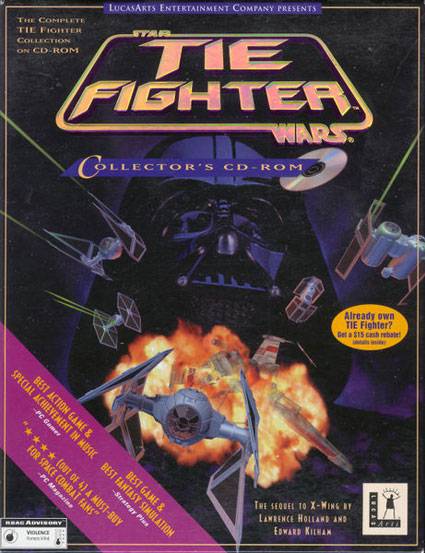My favorite flight sim features zero flyable airplanes, no actual historical battles, and has no realistic physics or damage modeling. In fact, it’s set in space in a fictional universe with implausible science, such as lasers that don’t hit their targets at the speed of light, and swords made of energy beams that arbitrarily stop 3 feet out from their hilts. If the article’s title didn’t tip you off (or the gigantic image of a TIE fighter), it’s 1994’s Star Wars: TIE Fighter, a brilliant space flight sim that incorporated elements from the flight sim genre into making a truly compelling action/simulation experience that Star Wars fans and PC gamers everywhere lauded. Sadly, Star Wars games of late have become trite, dumb action affairs that celebrate none of the nuance and rich history that fans of the series love so much. In contrast, TIE Fighter offered players a rich story coupled with space combat that pulled no punches in giving us a pseudo-realistic space sim, pretty much as close to piloting a Star Wars-universe spacecraft as any of us will ever get.
Players booting up Star Wars and expecting a Rogue Squadron-like experience will be overwhelmed by the relatively complex mechanics on offer here: no, it’s no IL-2 Sturmovik or even MS Flight Simulator, and you won’t find yourself messing around with fuel mixtures or blacking out, but it’s a fair bit tougher than the more casual fair. Scummy Rebel X-Wings on your tail? Divert energy from your engine to your shields, but be aware that you’ll be an easier target as your movement speed decreases. Did you frantically blow a torpedo salvo at a Y-Wing envoy early on in the mission? Too bad: no magical regenerating missiles will be coming your way; better hope there’s a resupply craft nearby. From choosing the correct craft for the mission and carefully selecting the best weapons loadout to blasting ion cannons to disable craft carrying sensitive information the great Emperor (may he live forever) doesn’t want destroyed, TIE Fighter is an action game for thinkers.
One of my fondest memories is turning on god mode and inifinite ammo–which were options in the menu, no cheats necessary!–and turning on my fellow TIE pilots, even daring an assault run on the Star Destroyer we launched from. Today, the only chance you get at destroying a whole frickin’ Star Destroyer is during a horribly conceived QTE sequence.
What was great about TIE fighter was the semblance of freedom it presented to the player: no, it wasn’t a Freelancer-level of exploration and open-ended gameplay, but within each mission, every craft had to play by the rules. Star Destroyers, Corellian battlecruisers, pylons, assault vehicles; nothing was off-limits assuming you had the firepower to destroy it. In most air combat games nowadays, the craft you’re not “supposed” to target are either invulnerable or they’re just a part of the 3D skybox. It’s a shame that a game from 1994 in many ways offered more “immersion” than current AAA releases.
For all my talk of its complexities, it really was an accessible game compared to some of its peers: the inclusion of a “match target speed” hotkey made dogfights much less painful, and the extensive tutorials prepared future TIE experts for combat quite thoroughly. The inventive Star Destroyer interior menu offered an easy way to jump into missions without fiddling around with too many options, though those were available in the options menu as well.
TIE Fighter’s legacy is rich, but sadly, most of its lessons have been forgotten today. The Rogue Squadron series, while fun, turned into a tightly constricted series of shoot-em-up missions, devoid of any sort of tactics or depth. Most other Star Wars titles have fallen victim to cinematic-itis, trying to thrust the player into an interactive movie that none of us asked to have a part in. Knights of the Old Republic is probably the last Star Wars title to offer a rich backstory and any level of interactivity anywhere near TIE Fighter. There was a cool sequel a while back called X-Wing Alliance that I also highly recommend; in fact, it’s more accessible from a modern standpoint due to its better graphics.
Star Wars: Galaxies came and went in the MMO universe, offering players a chance to be bartenders and cantina singers and moisture farmers. Looming large on the horizon is The Old Republic, promising to let players be Jedi Knights and an integral part to the storyline. I’d argue that though Galaxies wasn’t well-received, TIE Fighter shows us that it is possible to have a story focused around the “nobodies” of the Star Wars universe and still connect with an audience. When my grade school pals and I played “Star Wars” together, we never pretended to be Luke Skywalker or Darth Vader or the “secret apprentice” or anything: we were spice traders and bounty hunters and shop owners. I think a large part of what made TIE Fighter work was that the player was just a TIE pilot, at least in the beginning of the game.
LucasArts, bring back TIE Fighter. If not in name, then at least, I beg you, learn its lessons. Yes, The Force Unleashed 3 would sell more in the short run than a tactical space flight sim. Yeah, TIE Fighter won’t draw in the Call of Duty crowd easily. But with time and a long-term commitment to quality, gamers will begin to respect the LA name again, and sales will follow; TIE Fighter is a reminder to us all that complexity, accessibility, and mass appeal don’t have to be mutually exclusive.






I approve this post. Long live Tie Fighter!
One of my favorite games!!
I LOVE this game!!